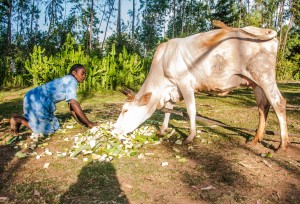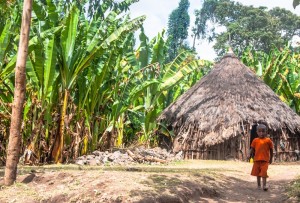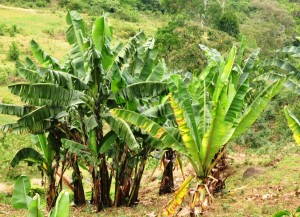“It is life. Without it there is no life,” Langano Mamo, 40 year old mother of five from Lage village in Sidama Zone in Southern Ethiopia summarizes the importance of enset in her life. Enset, also known as false banana because of its resemblance to the crop but its fruits are inedible, is an ancient indigenous crop in Ethiopia-the only country in the world where it has been domesticated and grown for over 10,000 years.
The crop is an important staple for over 20 million people in the central and Southern parts of Ethiopia where it is mostly grown by small-holder farmers such as Langano for food, livestock and fiber which is used for making baskets and constructing their traditional huts.
“We eat enset every day. We make very many traditional foods and snacks from the stem including Bulla, a porridge which is fed to women who have delivered for 40 days so they can regain their strength,” she says.

Langano feeds her cow leaves and pseudo stems of the enset. it’s an important food and livestock feed
However, the production of this ancient crop is greatly threated by the deadly bacterial wilt disease which attacks all its varieties and is found in all the enset growing areas of the country. The disease, caused by the bacterium Xanthomonas campestris pv. Musacearum (Xcm) was first detected in Ethiopia in 1968 in enset. In 2001 it was found in Uganda in banana and has since spread to other countries in east and central Africa such as eastern Democratic Republic of Congo (DRC), Rwanda, Tanzania, Kenya and Burundi where it causes annual loses of over USD 500 Million.
“We do not know how the disease was contained in Ethiopia for so, long over 30 years, or how it crossed over to Uganda. We assume it could be because of the weather as enset grows in cool areas in Ethiopia so its spread very slowly. However, once it enters a field, it spreads out very rapidly and can wipe off the banana and enset very fast,” says Dr Leena Tripathi, a plant biotechnologist with the International Institute of Tropical Agriculture (IITA). “The disease is threatening to wipe off banana and enset as scientists have failed to find any genes of resistance to the bacterium in banana and enset and their wild relatives after over 30 years of research.”
The disease is spread by insect vectors such as aphids and beetles; through sharing of infected planting material among farmers and the use of contaminated farming tools. Control measures are mostly sanitary where farmers are advised to use clean planting material and to disinfect farming tools after each use. They should also closely monitor their fields for the disease uprooting any plant that shows symptoms. , and letting their land to lay fallow for six months to ensure all the bacteria in the soil has been destroyed before replanting banana or enset.
“For the control measures to work, all farmers in a region must cooperate. One lax farmer can lead to failure and making all the other farmers efforts a waste,” Dr Tripathi explains. “The most effective control measure is to develop banana and enset varieties resistant to the disease.”
Green pepper to the rescue
With no known sources of resistance in the banana or enset and their wild varieties, scientists were forced to seek for the resistant genes elsewhere. Scientists from IITA and the National Research Organization (NARO), Uganda, identified two such genes in sweet pepper, Hypersensitive Response-Assisting Protein gene (Hrap) and a Plant Ferredoxin-Like Protein gene (Pflp) and they have successfully transferred the genes to some popular banana varieties. The transformed plants have shown very strong resistance to the disease in the lab, in screen houses and in confined field trials in Uganda. The genes were acquired from Academia Sinica Taiwan through the African Agriculture Technology Foundation (AATF).
It’s enset time

Enset growing near a homestead in Southern Ethiopia. It is an important food security crop in the country.
A new project led by IITA and funded by the by the Bill & Melinda Gates foundation is seeking to among others transfer this technology to enset to develop varieties that are resistant to the deadly disease in a bid to protect the food and livelihood security of over 20 million people in Ethiopia dependent on the crop.
“Enset is an important crop in Ethiopia. The discovery of the crop and the food processing technologies are indigenous to Ethiopia. The crop is also resistant to drought and is one the crops that small-holder farmers can rely on in the face of climate change. However, the wilt is a production challenge that our scientists have been addressing for many years with little success in developing resistant varieties,’ said Dr Adugna Wakjira, the Deputy Director of the Ethiopian Institute of Agricultural Research (EIAR) while officially launching the project
“Currently all control measures are sanitary. This project is therefore very timely and relevant to the country as we have to use modern tools in addition to our traditional conventional breeding to solve this problem,” he said.
The project will also work with the policy makers to put in place the necessary policy and regulations in place to allow such research to be conducted in the country.
“Each time I meet farmers they ask me to save their dying enset. We have been conducting research on enset for over 30years and we have received seven improved varieties. But they are all susceptible to the disease except for one which shows mild tolerance. This project is therefore very welcome,” says Dr Nigussie Dana, the Director General for the Southern Agriculture Research Institute in Hawassa – the heart of enset growing land.
‘We are happy that enset is now receiving the attention it deserves. The crop despite being important to over a quarter of the population of the country
has been an orphan crop receiving less attention from researchers as compared to cereals and cash crops. It is also relatively unknown among international researchers as it is only an important staple in Ethiopia,” he said.
The project was initiated following on a report “Assessment of Biotechnology and Biosafety Capacity in Ethiopia” conducted by a team from AU/NEPAD African Biosafety Network of Expertise (ABNE), Burkina Faso; Michigan State University (MSU), USA and Agricultural Transformation Agency (ATA), Ethiopia.
After the assessment, ATA requested the Gates foundation to support collaborative initiatives between EIAR and IITA to build the capacity of national scientists and research facilities to conduct transgenic research and to support policy makers to effectively create an improved policy environment to facilitate the research in the country.




No Comments